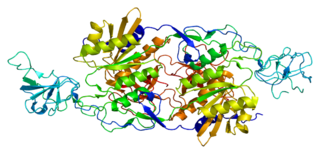Glycine receptor subunit alpha-1 is a protein that in humans is encoded by the GLRA1 gene. [5] [6]
Glycine receptor subunit alpha-1 is a protein that in humans is encoded by the GLRA1 gene. [5] [6]
The inhibitory glycine receptor mediates postsynaptic inhibition in the spinal cord and other regions of the central nervous system. It is a pentameric receptor composed solely of alpha subunits. The GLRB gene encodes the alpha subunit of the receptor. [7]
Mutations in the gene have been associated with hyperekplexia, a neurologic syndrome associated with an exaggerated startle reaction. [8] [9]

Hyperekplexia is a very rare neurologic disorder, classically characterised by a pronounced startle responses to tactile or acoustic stimuli and an ensuing period of hypertonia. The hypertonia may be predominantly truncal, attenuated during sleep, or less prominent after one year of age.

Sodium channel protein type 4 subunit alpha is a protein that in humans is encoded by the SCN4A gene.

Gephyrin is a protein that in humans is encoded by the GPHN gene.

Collagen alpha-2(I) chain is a protein that in humans is encoded by the COL1A2 gene.

Gamma-aminobutyric acid receptor subunit alpha-1 is a protein that in humans is encoded by the GABRA1 gene.

Collagen alpha-5(IV) chain is a protein that in humans is encoded by the COL4A5 gene.

Neuronal acetylcholine receptor subunit alpha-4, also known as nAChRα4, is a protein that in humans is encoded by the CHRNA4 gene. The protein encoded by this gene is a subunit of certain nicotinic acetylcholine receptors (nAChR). Alpha4-containing nAChRs appear to play a crucial role in the addictive response to nicotine.

Acetylcholine receptor subunit epsilon is a protein that in humans is encoded by the CHRNE gene.

Phosphorylase b kinase regulatory subunit alpha, liver isoform is an enzyme that in humans is encoded by the PHKA2 gene.

Cav1.1 also known as the calcium channel, voltage-dependent, L type, alpha 1S subunit, (CACNA1S), is a protein which in humans is encoded by the CACNA1S gene. It is also known as CACNL1A3 and the dihydropyridine receptor.

Gamma-aminobutyric acid receptor subunit beta-1 is a protein that in humans is encoded by the GABRB1 gene.

Gamma-aminobutyric acid receptor subunit alpha-6 is a protein that in humans is encoded by the GABRA6 gene.

Sodium- and chloride-dependent glycine transporter 2, also known as glycine transporter 2 (GlyT2), is a protein that in humans is encoded by the SLC6A5 gene.

Acetylcholine receptor subunit delta is a protein that in humans is encoded by the CHRND gene.

Phosphorylase b kinase gamma catalytic chain, testis/liver isoform is an enzyme that in humans is encoded by the PHKG2 gene.

Gamma-aminobutyric acid (GABA) A receptor, alpha 5, also known as GABRA5, is a protein which in humans is encoded by the GABRA5 gene.

Acetylcholine receptor subunit beta is a protein that in humans is encoded by the CHRNB1 gene.

Gamma-aminobutyric acid receptor subunit alpha-4 is a protein that in humans is encoded by the GABRA4 gene.

Glycine receptor subunit beta is a protein that in humans is encoded by the GLRB gene.

Glycine receptor subunit alpha-2 is a protein that in humans is encoded by the GLRA2 gene.
This article incorporates text from the United States National Library of Medicine, which is in the public domain.